#national library of brazil
Explore tagged Tumblr posts
Text

Rushmore (1998, Wes Anderson)
08/12/2024
#rushmore#film#1998#wes anderson#jason schwartzman#bill murray#olivia williams#owen wilson#national film registry#library of congress#1999#united states#australia#portugal#netherlands#slovakia#argentina#new zealand#Singapore#iceland#uruguay#norway#hungary#denmark#belgium#greece#brazil#israel#turkey#united kingdom
6 notes
·
View notes
Text

National Library in Rio de Janeiro, Brazil
Brazilian vintage postcard
#carte postale#postkarte#historic#postcard#sepia#ansichtskarte#postkaart#tarjeta#brazilian#rio de janeiro#library#brazil#national library#briefkaart#ephemera#photography#janeiro#vintage#postal#photo#national
17 notes
·
View notes
Photo

Barefoot in the Park, a man who walked 10,000 kilometers for five years, saw his final destination Surprise
#Mystic TV: Surprise#Brazil#National Library of Norway#Anton Lavey#Canada#Barefoot in the Park#Surprise#Toronto#Argentina#Buenos Aires#Mexico#The Departure#Jungle
0 notes
Text
Indigenous people welcome return of 16th-17th century cloak to Brazil
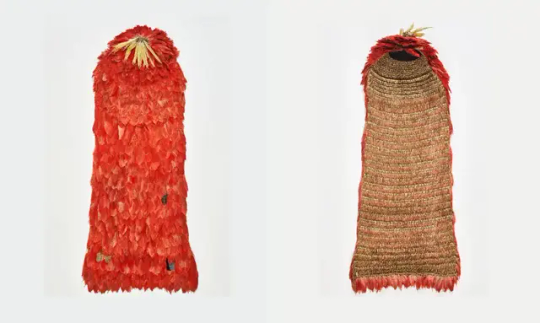
The return of a Tupinambá cloak made from red guará bird feathers to Brazil, after more than three centuries in storage in Denmark, was a reason for celebration among the indigenous people in southern Bahia. The Danish National Museum donated the artifact to the National Museum in Rio de Janeiro.
The Brazilian museum confirmed the cloak's arrival on July 11 and announced plans to exhibit the piece in the coming weeks.
However, ten other similar cloaks, also made from guará feathers, remain in European museums, according to a survey by American researcher Amy Buono from Chapman University in California, USA.
According to the research, there are four more cloaks in the National Museum of Denmark, in addition to the one that was returned to Brazil. The Natural History Museum of the University of Florence, Italy, holds two others. Additionally, Tupinambá cloaks can be found in the Museum of Cultures in Basel, Switzerland; the Royal Museum of Art and History in Brussels, Belgium; the Quai Branly Museum in Paris, France; and the Ambrosian Library in Milan, Italy.
Continue reading.
#brazil#brazilian politics#politics#indigenous rights#denmark#museums#image description in alt#mod nise da silveira
47 notes
·
View notes
Text
as always, I am compelled to ramble about the race
Poor yuki and Alex omg they could not catch a break this weekend. Yuki’s post race interview made me want to fight whoever made him sad, but alas I lack the ability and it was a racing incident anyways
seb was on to something when he said that everyone is a Ferrari fan, even if you’re not, cause despite neither of the drivers being my favs the joy when they win is so damn contagious (side note, the Italian national anthem slaps). It was great to see Carlos so happy
lawson managed to start beef with both latino drivers and one of the spaniards (the dangerous one) which is hilarious
Lando also seemed really happy after the race, which was adorable. He’s also incapable of having an interview now without yapping about max and respect and I’ll be so amused if we find out he was standing next to/near max again while giving those interviews
the haasband excellence! The blond European fathers who race for the American team with a German name slayed this race. Obvs I wish they’d pulled over and let my king Oscar past, but seriously they and the team have been pushing so hard for a result like this and I’m so happy for them. Kmag has found some kind of nirvana and I need him to share his secrets
Oscar fought for every place and made the most of his race, giving us plenty of fabulous on track action. Obviously he’d kill for a redo of his q1 lap yesterday but alas, even a blood sacrifice can’t make that happen. He even swore on the radio, tee hee!
love to see McLaren and Ferrari having fun with each other in their team photos after the race, that’s the best kind of competition
finally, the penalties. I’m so far from qualified to hand down judgement on whether they were right or not (do love max being sassy about not complaining over them, throw that shade) so I’m just gonna sit here and watch other people yap about it, and I do expect to be thoroughly amused by that
wait wait one more thing, people kept calling Carlos the king of Mexico! The first time it happened my friend and I burst into laughter in the library, like obvs no one means anything by it except complimenting Carlos on his weekend but it’s so hysterical to me considering I’m pretty sure there was at least one war about Mexico having a Spanish king and yet! here the commentators are
all in all, a fabulous and entertaining race that will certainly have a fabulous and entertaining aftermath. Now, on to Brazil!!!
#mexico gp 2024#formula 1#just yappin#carlos sainz#haasbands#yuki tsunoda#It’s gonna be so funny if Red Bull ends in 3rd while max wins drivers
13 notes
·
View notes
Text
ANDRÉ LEBLANC
@thealmightyemprex @themousefromfantasyland @the-blue-fairie @princesssarisa @piterelizabethdevries @themetropoliskonboy @a-roguish-gambit @knivxsanddespair @professorlehnsherr-almashy @gravedangerahead @softlytowardthesun

Early life André LeBlanc was born in 1921 in Haïti as the son of a French mother and Honduran father. LeBlanc's path of life led him through several countries, spending many years in the USA, Cuba and Brazil. In a March 1972 interview with O Pasquim magazine, LeBlanc said he had little memories of his time in Haiti. During the 1920s, the family already moved to the United States, where André LeBlanc spent the largest part of his childhood. In New York, he got his artistic training at the Art Students League, while debuting in the upcoming comic book industry.
American comic books In 1939, eighteen-year-old André LeBlanc got a job with the New York City-based comic production studio of Will Eisner and Jerry Iger. There, he was initially an assistant doing backgrounds and inking on the team's comic book production - largely for Quality Comics and Fiction House - while learning the trade from Will Eisner, Reed Crandall, Lou Fine and other associated artists. Among his other influences were the magazine illustrators Harold Von Schmidt, Matt Clark and Tom Lovell.
When Eisner-Iger was dissolved in 1940, LeBlanc worked for production studios led by Jerry Iger solo (S.M. Iger, founded in 1940) and Jack Binder (Binder Studio, founded in 1942), and also directly for publisher Everett M. "Busy" Arnold, who ran Quality Comics. At Binder, LeBlanc worked alongside Lee Ames and Dan Barry, who became lifelong friends of his. During these early years of his career, LeBlanc did pencil and/or inking duties on features like 'Sheena, Queen of the Jungle', 'Steve Brodie', 'Famous Fighters', 'Kayo Kirby' and 'Rip Carson' for comic books published by Fiction House Comics. At Fawcett Comics, he worked on superheroes like 'Bulletman', 'Captain Marvel', 'Golden Arrow' and 'Spy Smasher', while his Quality Comics contributions included work on 'Destroyer 171' in National Comics and 'P.T. Boat' in Military Comics. As an inker, he regularly worked with pencil artist John Spranger. During the 1940s, André LeBlanc also illustrated pulp magazines and occasional comic book stories for Street and Smith publishers.
Around 1943-1944, LeBlanc had to leave the USA for Cuba to take care of the estate of his recently deceased father, who was growing sugar and coffee on a piece of land. After wrapping up his father's businesses, he decided to stay and settled in Havana, which at the time, as he recalled in the O Pasquim interview, was a blossoming city populated by intellectual fugitives, spies of all nationalities and Spanish exiles.

Intellectual Amos While in Cuba, André LeBlanc got an idea for his own comic feature, and submitted it to his former boss in the USA, publisher Everett M. "Busy" Arnold. Intended as a protest against the superhero genre, 'Intellectual Amos' (1944-1945) was about a boy who was abandoned at the door of a library. Growing up there, he read everything and became an intellectual, who fought villains with his childlike innocence, unusual powerful memory and knowledge gained from reading. With four pages a week, 'Intellectual Amos' ran as a back-up feature in Will Eisner's Sunday newspaper supplement 'The Spirit Section' starting on 21 May 1944.
André LeBlanc continued to produce 'Intellectual Amos' when in 1944 he moved from Cuba to Brazil. There, he married his Brazilian wife Elvira Telles and settled in Niterói, a residential suburb of Rio de Janeiro. However, mailing his weekly comic pages to the USA eventually became problematic. The packages were intercepted by US customs and heavily taxed as works of art. Publisher Arnold was not prepared to pay the thousand dollar fine, and as a result the weekly 'Intellectual Amos' feature came to an accidental end on 29 April 1945. It was replaced by Al Stahl's 'Flatfood Burns'. Between February 1945 and August 1947, longer monthly stories with Amos and his sidekick Wilbur the Goblin appeared in Quality Comics titles like Police Comics and National Comics.

Work in Brazil With his regular assignment in the USA coming to an end, LeBlanc began exploring the Brazilian market. One of his first publications there was the cover for issue #1914 of the children's magazine O Tico-Tico (May 1945). He then also illustrated double-page short story spreads for the weekly magazine O Cruzeiro, and contributed to the cultural monthly A Cigarra.

He later also did commercial art assignments through the São Paulo branch of the J. Walter Thompson advertising agency. For Editora Brasiliense, he made the interior illustrations for almost all the re-editions of the children's books by Monteiro Lobato (1882-1948); the cover drawings were by Augusto Mendes da Silva (AKA Augustus/Avgvstvs).

Morena Flor One of LeBlanc's best-known Brazilian comic creations was 'Morena Flor' (1948-1951), a daily strip of 833 episodes, published in the newspaper Diario da Noite. Debuting on 16 August 1948, Morena was a Brazilian jungle girl who fought the despoilers of the Amazon. Through Luiz Rosemberg's Agência Periodista Latino-Americana, LeBlanc's ecologically-themed strip was also distributed to newspapers in Argentina, Chile and Mexico. In 1953, the stories were also reprinted as a back-up feature in Capitão Atlas, a comic book based on the radio serial created by Péricles do Amaral.

Edição Maravilhosa Between 1950 and 1954, LeBlanc was also a prominent artist for the comic book collection 'Edição Maravilhosa - Clássicos Ilustrados', published by Adolfo Aizen's publishing company EBAL (Edição Maravilhosa da Editora Brasil-América Limitada). The Brazilian answer to the American 'Classics Illustrated' series, the Edição Maravilhosa comic books adapted important titles of Brazilian literature into comics.
LeBlanc notably drew the installments with adaptations of works by the 19th-century Brazilian Romantic novelist José de Alencar ('O Guarani', 'Iracema', 'Ubirajara', 'O Tronco do Ipê') and the regionalist novelist José Lins do Rego ('O Menino de Engenho', 'Doidinho', 'Banguê', 'Cangaceiros').
He additionally adapted classic novels by Joaquim Manuel de Macedo ('A Moreninha'), Dinah Silveira de Queiroz ('A Muralha'), Gastão Cruls ('A Amazônia Misteriosa'), Maria Dezonne Pacheco Fernandes ('Sinhá Moça') and Herberto Sales ('Cascalho').
Among the other artists working for this collection were Manoel Victor Filho, Nico Rosso, Ramón Llampayas, Aylton Thomaz, Gil Coimbra, José Geraldo and Gutemberg Monteiro.


Traveling reporter During the 1950s, LeBlanc also worked as an illustrator-reporter for the Brazilian newspapers Correiro da Manha and O Globo. For the latter, he traveled to the East for a series of 36 illustrated reports, first visiting India (Bombay, Benares, Agra, Calcutta, Goa), then going through Pakistan and the region that is now Bangladesh. After six months, he returned home through Europe.
In 1956, LeBlanc moved back to New York, where his wife could undergo medical treatment for a complication in her spine.
The treatment lasted more than a year, and the LeBlanc family decided to stay. In 1969, they went back to Brazil once again, but returned to the States a couple of years later. In Brazil, LeBlanc was part of a select group of cutting-edge illustrators that flourished in the country, but the repression of the military dictatorship made life difficult. In interviews, he expressed concerns about raising his children in the country.
A polyglot himself, he preferred to have his children educated in English instead of Portuguese.

U.S. comic book work Already in the second half of the 1940s, LeBlanc had renewed his old contacts in the United States. Between 1947 and 1948, he assisted his old taskmaster Will Eisner on the inking of 'The Spirit'. In 1949, he also contributed to the single issue of Eisner's children's comic book Kewpies, drawing the 'Pito' feature. He was also back at Quality Comics, drawing the 'Poodle Mc Doodle' feature in Modern Comics. Between 1951 and 1953, LeBlanc drew stories for Quality's 'Plastic Man' comic book, following in the footsteps of the series' creator, fellow former Eisner co-worker Jack Cole. LeBlanc's closeness with Will Eisner persisted over the years. In 1983, he helped his old friend with the colorization of his graphic novel 'Signal from Space'.
During the 1950s, even before his return to the USA, LeBlanc continued to work for American comic book companies. In 1952-1953, he drew a couple of crime and horror stories for 'Authentic Police Cases' and 'Weird Horrors' by St. John Publishing.
A couple of years later, he was present at Dell Comics, drawing comic adaptations of 'The Hunchback of Notre Dame' (1957) and 'The Pride and the Passion' (1957) for the publisher's Four Color Comics line of one-shot books.
According to Jerry Bails' 'Who is Who' index, LeBlanc possibly drew episodes of features like 'My Paul, Alien', 'Spyman' and 'Super Surplus' for Harvey Comics in 1966. Between 1966 and 1968, he was working for Western Publishing, drawing about a dozen stories for the anthology titles 'Ripley's Believe It Or Not', 'The Twilight Zone' and 'Boris Karloff Tales of Mystery'.
For the 1967 'Wham-O Giant Comics' anthology - published by the Wham-O toy company - LeBlanc made the three-page World War I story about 'The Young Eagles'. Between 1966 and 1967, LeBlanc was a penciler and inker for the 'Mandrake the Magician' title of King Comics, the comic book imprint of King Features Syndicate. It was the first time he worked with one of Lee Falk's creations; more followed later in his career.
Ghost artist for newspaper comics For a large part of his career, André LeBlanc was happy to work in the service of others. Besides assisting Will Eisner, he spent long periods of time doing well-paid jobs as assistant and ghost artist for newspaper comics.
Between 1957 and 1959, he regularly helped his former Binder Studio colleague Dan Barry with the 'Flash Gordon' newspaper comic. During this same period, he ghosted for Dan's brother Sy Barry on large parts of the civil rights comic book 'Martin Luther King and the Montgomery Story' (Fellowship of Reconciliation, 1958).
Around 1976, he replaced George Olesen as Sy Barry's regular assistant on the newspaper comic with Lee Falk's 'The Phantom'.
One notable sequence penciled and inked anonymously by LeBlanc were the 1977 daily strips and Sunday pages detailing the Phantom's marriage to Diana Palmer.
LeBlanc continued to work with Sy Barry on an on-again off-again basis until the latter's retirement in 1994.


In the 1970s, LeBlanc also did some assistant work on the 'Mandrake the Magician' newspaper comic, another Lee Falk creation, drawn for King Features Syndicate by Fred Fredericks.
In August-September 1976 and August-October 1978, he additionally helped Alex Kotzky with the 'Apartment 3-G' strip and in the 1978-1979 period, he also ghosted on both Sunday and daily episodes of the 'Rex Morgan, M.D.' strip for Frank Edgington and Marvin Bradley.
Our Bible in Pictures LeBlanc's biggest claim to fame was arguably the Bible series he did for publisher David C. Cook. The origins of the project lay in the early 1950s, when Cook had Reverend David S. Piper write and Joseph Wirt Tillotson draw Bible stories in picture story format, added as "take home" supplements to Sunday Pix, a Christian comic book aimed at Sunday School pupils. By 1958, plans for a full Bible comic adaptation came about. Editor Iva Hoth was chosen to write the text to go with the pictures, while LeBlanc was hired as illustrator. Between October 1959 and 1964, 'Our Bible in Pictures' appeared as weekly installments of three to four pages in Sunday Pix. In 1964, selections of the feature were collected as the 'Life of Jesus' book, which appeared with editions in English, Dutch, Finnish, Indonesian, Japanese, Norwegian, Russian, Spanish, and Swedish.

In 1973, the first book version of the entire series appeared in black-and-white as the six-volume 'The Picture Bible for All Ages' collection. For reprints later that decade, LeBlanc was assigned to colorize the entire project. In 1978, a New Testament version appeared, followed in 1979 by 'The Picture Bible', containing both the Old and New Testaments in 750 full-color comic pages. Since then, the book has often been reprinted, becoming a worldwide hit. Interviewed in May 2001, the director of Cook Communications Ministries International, Ralph Gates, estimated that 75 million copies of the Picture Bible had been distributed around the world with translations in over 130 languages, including Russian, Spanish, Portuguese, Hungarian, Romanian and Tagalog. In 2010, David C. Cook Publishing released a new and modernized version of 'The Picture Bible', entitled 'The Action Bible', with scripts by Doug Mauss and artwork by Sergio Cariello.
Other work Following the immense success of this ambitious Bible project for David C. Cook, LeBlanc became a sought-after illustrator for other Bible-related projects, including work for magazines and Sunday schools. In the mid-1980s, he was hired by Hanna-Barbera as character designer for the animated direct-to-video series 'The Greatest Adventure Stories from the Bible' (1985-1992). Years earlier, he had already worked for Hanna-Barbera as an in-betweener on the animated TV show 'Space Ghost and Dino Boy' (1966-1968).
During the 1950s, LeBlanc also teamed up with former Binder Studio colleague Lee Ames to illustrate children's textbooks for publisher MacMillan. Represented by Ames' agent Mary Gerard, LeBlanc also landed jobs with other educational publishers, such as Allyn & Bacon. With Ames, he additionally collaborated on book projects like 'George Washington: Frontier Colonel' (Random House, 1957) and 'Draw 50 People from the Bible' (Watson-Guptill, 1995).
In 1959, LeBlanc was a contributing illustrator to the twelve-volume 'Picture World Encyclopedia' series, edited by Gene Fawcette. He illustrated paperback novels like 'Snow Treasure' by Marie McSwigan (Scholastic, 1958) as well as a mid-1980s sex manual, while doing commercial art assignments through the Ted Bates Advertising Agency. He was additionally an instructor at New York City's School of Visual Arts.

Recognition and legacy

In Brazil, André LeBlanc was awarded the prestigious "Southern Cross" - the highest honor that can be bestowed upon a Brazilian citizen - for his illustrations for classical literature.
After a long and varied career, André LeBlanc died in the USA on 21 December 1998, at the age of 77. Dividing his time between the USA and Brazil, LeBlanc worked in many fields and genres.
From the blossoming American comic book market to Brazilian journalism and youth literature, and from religious publications to newspaper comics. In articles, LeBlanc was described as a person with a great curiosity and intellect.
During his lifetime, he learned how to speak six languages fluently. He was also known for his keen understanding of science, politics, history and arts. These character traits he shared with his signature creation, 'Intellectual Amos'.
This boy genius can be considered a forerunner to later comic book whiz kids like 'Génial Olivier' by Jacques Devos in the Belgian Spirou magazine (1963-1988), and Alan Moore and Kevin Nowlan's 'Jack B. Quick' (1999-2002) at DC Comics in the USA.
André LeBlanc was also cited as an influence on Flavio Colin.
14 notes
·
View notes
Text

Dr. Yosef Ben-Jochannan (December 31, 1918 - March 19, 2015) was a historian whose work is focused mainly on the Black presence in ancient Egypt. He contends in his writings that the pharaohs came out of the heart of Africa that the original Jews were from Ethiopia and were Black Africans, and that the white Jews adopted the faith and customs.
He was born an only child to an Ethiopian father and an Afro-Puerto Rican Jewish mother in a Falasha community in Ethiopia. He attended schools in Brazil, Spain, Puerto Rico, and Cuba and earned degrees in Engineering and Anthropology. He continued his education at the University of Havana, where he earned an MS in Architectural Engineering. He earned a Ph.D. in Cultural Anthropology from the same school, and he attended the University of Barcelona, where he earned a Ph.D. in Moorish history.
He immigrated to the US in the early 1940s. He was appointed chairman of the African Studies Committee at UNESCO headquarters. He began teaching Egyptology at Malcolm King College and he taught at City College in New York. He was an adjunct professor at Cornell University. He has taught at Columbia University, Al-Azan University, and Rutgers. He led an archaeological dig in the Nubia region of Egypt and led an annual trip of Black people to Egypt.
He is a prolific author, penning 49 books, such as Black Man of the Nile and African Origins of Western Religions. The subject of most of his books is ancient Nile Valley civilizations. He wrote and co-wrote elementary and secondary school texts. He is the chair of the publishing house Alkebu-Lan Foundation and its subsidiary, Alkebu-Lan Books and Education Materials Associates. He donated his library of more than 35,000 volumes to the Nation of Islam in 2002. #africanhistory365 #africanexcellence
5 notes
·
View notes
Text
Holidays 12.13
Holidays
Acadian Remembrance Day (Canada)
Anesthesia Technicians Day (Turkey)
Bicycle Built For Two Day
Blame Someone Else Day
Clip-On Tie Day
Count the "La's" in "Deck the Halls" Day
Ella Josephine Baker Day
General Trias Foundation Day (Philippines)
International ACAB Day
Jane Addams Day
Jum ir-Repubblika (Malta)
Local Charities Day (UK)
Loki Day
Martial Law Victims Remembrance Day (Poland)
Nanking Massacre Memorial Day (China)
National Bring Your Brother-in-Law to Work Day
National Day (Saint Lucia)
National Day of the Horse [also 2nd Saturday]
National Guard Day (US)
National Violin Day
National Give a Wine Club Day
New Calendar Day
Nusantara Day (Indonesia)
Peace Day (Korea)
Pick a Pathologist Pal Day
Reed Plant Day (French Republic)
Republic Day (Malta)
Sailor’s Day (Brazil)
Santa Lucia Day (Sweden, Scandinavia)
Skip Day
Swiftie Day
Unreturned Library Book Day
World Violins Day
Yuletide Lad #2 arrives (Giljagaur or Gully Gawk; Iceland)
Food & Drink Celebrations
Ice Cream and Violins Day
National Cocoa Day
National Cream Cheese Frosting Day
National Ice Cream Day
National Popcorn String Day
Saffron Bun Day (Sweden)
World Raclette Day
Independence & Related Days
Malta (Republic Declared; 1974)
Vendsyssel (Declared; 2018) [unrecognized]
2nd Friday in December
Comfort Food Friday [Every Friday]
Five For Friday [Every Friday]
Flashback Friday [Every Friday]
Friday Finds [Every Friday]
Friday the Firkenteenth (Grey Lodge, Pennsylvania)
Fry Day (Pastafarian; Fritism) [Every Friday]
National Salesperson Day [2nd Friday]
Official Lost and Found Day [2nd Friday]
Purple Friday (Netherlands) [2nd Friday]
TGIF (Thank God It's Friday) [Every Friday]
World Brandy Day [2nd Friday]
Weekly Holidays beginning December 13 (2nd Full Week of December)
None Known
Festivals Beginning December 13, 2024
Candy Cane Hunt (Lenexa, Kansas)
Christmas on the River (Savannah, Georgia) [thru 12.14]
Country Christmas Festival (Tylertown, Mississippi) [thru 12.14]
4th Avenue Winter Street Fair (Tucson, Arizona) [thru 12.15]
International Film Festival of Kerala (Thiruvananthapuram, India) [thru 12.20]
Night of the Proms (Hamburg, Germany) [thru 12.14]
Saint Kitts and Nevis National Carnival [Sugar Mas] (Basseterre, Saint Kitts and Nevis) [thru 2.2.2025]
Woodstock Winter Wassail Weekend (Woodstock, Vermont) [thru 12.15]
Feast Days
Antiochus of Sulcis (Christian; Saint)
Antoni Tàpies (Artology)
Aubert of Cambrai (Christian; Saint)
Comp-U-Coffee 2000 (Muppetism)
Emily Carr (Artology)
Emma Bull (Writerism)
Euler (Positivist; Saint)
Eustratius and His Companions (Christian; Martyrs)
Feast of the Light-Bringer (Old Swedish Goddess of Light)
Franz von Lenbach (Artology)
Heinrich Heine (Writerism)
Herman of Alaska (American Orthodox Church)
Ides of December (Ancient Rome)
James Wright (Writerism)
John Marinoni (Christian; Blessed)
John Wayne Day (Church of the SubGenius; Saint)
Judoc (a.k.a. Joyce; Christian; Saint)
Kenelm, King (Christian; Saint)
Kenneth Patchen (Writerism)
Larry Storch Day (Church of the SubGenius; Saint)
Leonard Weisgard (Artology)
Losoong (a.k.a. Namsoong; Sikkim, India)
Luciadagen (a.k.a. Little Yule; Scandinavia)
Lucia’s Day (Pagan) [Sweden]
Lucy (Christian; Saint) [Writers]
Monkey Appreciation Day (Pastafarian)
Odile of Alsace (Christian; Saint)
Othilia (a.k.a. Odilia; Christian; Saint & Virgin)
The Sementivaem (Ancient Rome)
Tellus (Ancient Rome, with table spread for Ceres)
Thorn Cutting Ceremony Day (Glastonbury, England; Celtic)
Unreturned Library Books Sale (Imps; Shamanism)
Lucky & Unlucky Days
Prime Number Day: 347 [69 of 72]
Taian (大安 Japan) [Lucky all day.]
Unlucky Day (EU, US) [Friday the 13th] (2 of 2 for 2024)
Unlucky Day (Canada, Germany, Ireland, UK, US) [Friday the 13th]
Premieres
Accordion Joe (Betty Boop Cartoon; 1930)
Agents of S.H.I.E.L.D.: Slingshot (Web Series; 2016)
Alice’s Brown Derby (Ub Iwerks Disney Cartoon; 1926)
American Hustle (Film; 2013)
An American in Paris, by George Gershwin (Tone Poem; 1928)
Bedknobs and Broomsticks (Disney Film; 1971)
Beyoncé, by Beyoncé (Album; 2013)
Bugsy (Film; 1991)
Calling Dr. Woodpecker (Woody Woodpecker Cartoon; 1963)
A Chorus Line (Film; 1985)
Clue (Film; 1985)
Dark Star, performed by the Grateful Dead (Song; 1967)
Driving Miss Daisy (Film; 1989)
Emily of New Moon, by L.M. Montgomery (Novel; 1923)
Fool Coverage (WB LT Cartoon; 1952)
Foxy Lady, recorded by Jimi Hendrix (Song; 1966)
The Getaway (Film; 1972)
The Hobbit: The Desolation of Smaug (Film; 2013) [Hobbit #3]
Jerry Maguire (Film; 1996)
The Jewel of the Nile (Film; 1985)
Jumanji: The Next Level (Film; 2019)
The Lord of the Rings: The War of the Rohirrim (Animated Film; 2024)
Maid in Manhattan (Film; 2002)
Mars Attacks! (Film; 1996)
A Miser Brothers’ Christmas (Animated TV Special; 2008)
Monitored Noose or The Carbon Copy-Cats (Rocky & Bullwinkle Cartoon, S1, Ep. 6; 1959)
My Name is Nobody (Film; 1973)
Popeye Presents Eugene, the Jeep (Fleischer Popeye Cartoon; 1940)
The Poseidon Adventure (Film; 1972)
Rakuen Tsuiho: Expelled from Paradise (Anime Film; 2014)
Richard III (Film; 1955)
Saving Mr. Banks (Film; 2013)
Scooby-Doo! Pirates ahoy! (WB Animated Film; 2005)
The Scorched Moose (Rocky & Bullwinkle Cartoon, S1, Ep. 5; 1959)
Sense and Sensibility (Film; 1996)
6 Underground (Film; 2019)
The Snow Man (Terrytoons Cartoon; 1940)
Star Trek: Nemesis (Film; 2002)
Summertime (Terrytoons Cartoon; 1931)
Symphony No. 2 in C Minor, by Gustav Mahler (Symphony; 1895)
Symphony of Psalms, by Igor Stravinsky (Choral Symphony; 1930)
’Tis the Season to Be Smurfy (Hanna-Barbera Animated TV Special; 1987)
Tristessa, by Jack Kerouac (Novel; 1960)
Uncut Gems (Film; 2019)
Wild and Woody! (Woody Woodpecker Cartoon; 1948)
Wind (Pixar Cartoon; 2019)
Ye Olde Toy Shop (Terrytoons Cartoon; 1935)
Today’s Name Days
Jodok, Lucia, Odilia (Austria)
Jasna, Lucija, Otilija, Svjetlana (Croatia)
Lucie (Czech Republic)
Lucia (Denmark)
Ele, Ere, Hele, Loviise, Lucia, Luise, Viise (Estonia)
Seija (Finland)
Jocelyn, Lucie (France)
Jodok, Johanna, Lucia, Ottilia (Germany)
Aris, Efstratios, Ioubenalios, Evstratios, Loukia, Lucy, Stratos (Greece)
Luca, Otilia (Hungary)
Antioco, Lucia (Italy)
Lūcija, Veldze (Latvia)
Eiviltė, Kastautas, Kastytis, Liucija, Otilija (Lithuania)
Lucia, Lydia (Norway)
Łucja, Lucja, Otylia, Włodzisława (Poland)
Dosoftei (Romania)
Lucia (Slovakia)
Lucía, Otilia (Spain)
Lucia (Sweden)
Louise, Lucia, Lukia (Ukraine)
Cinderella, Cindy, Cynth, Cynthia (USA)
Today is Also…
Day of Year: Day 348 of 2024; 18 days remaining in the year
ISO: Day 5 of Week 50 of 2024
Celtic Tree Calendar: Ngetal (Reed) [Day 20 of 28]
Chinese: Month 11 (Bing-Zi), Day 13 (Xin-Hai)
Chinese Year of the: Dragon 4722 (until January 29, 2025) [Wu-Chen]
Hebrew: 12 Kislev 5785
Islamic: 11 Jumada II 1446
J Cal: 18 Black; Foursday [18 of 30]
Julian: 30 November 2024
Moon: 96%: Waxing Gibbous
Positivist: 12 Bichat (13th Month) [Daniel Bernouilli / D'Alembert]
Runic Half Month: Jara (Year) [Day 7 of 15]
Season: Autumn or Fall (Day 82 of 90)
Week: 2nd Full Week of December
Zodiac: Sagittarius (Day 22 of 30)
3 notes
·
View notes
Text
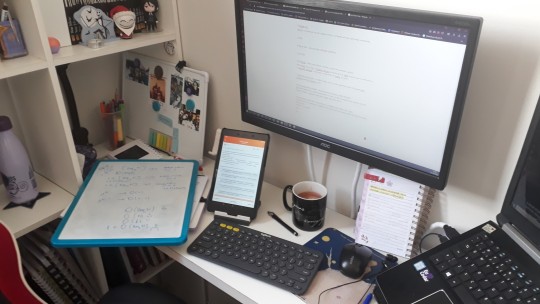
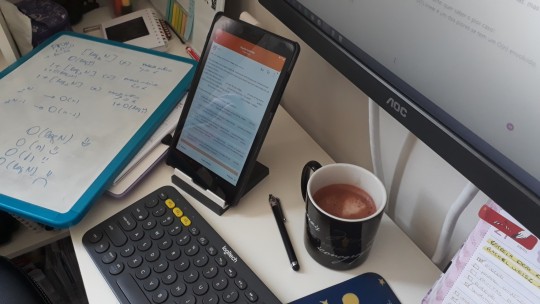
April 21, 2023 - Friday
Holiday in Brazil today, and I am using it to make a big review of the subjects of my Sunday exam.
I read so much about Java concepts, tools, frameworks and libraries, that I thought I would faint 😅 Oh! And also PostgreSQL, Swift, SQL and NoSQL... God! How can they include so many things in a single exam!
Well, there's no time to cry 🤣 Tomorrow I will continue my review early in the morning, go to the gym, study some more, and then relax a little in the afternoon.
My subjects tomorrow are: Python (Pandas and Numpy), Portuguese grammar, bank and national finance, and Math 😭
I have so much to do until Sunday, but it is OK, I will be fine🙏🏾
Wishing you all a great weekend!
#studyblr#study#study blog#daily life#dailymotivation#study motivation#study space#my desk#study desk#hot cocoa#productivity#stemblr#studying#programming#java#programming community#coding community
60 notes
·
View notes
Text

Notorious (1946, Alfred Hitchcock)
05/09/2024
#notorious#1946#alfred hitchcock#2001#American Film Institute#AFI's 100 Years 100 Thrills#2002#AFI's 100 Years 100 Passions#2006#national film registry#library of congress#united states#miami#florida#brazil#rio de janeiro#uranium#spain#David O Selznick#spellbound#John Taintor Foote#convoy#Joseph C Boyle#Lothar Mendes#ben hecht#ingrid bergman#Under Capricorn#cary grant#suspicion#north by northwest
4 notes
·
View notes
Note
hi, it's me again hehe I'm Brazilian and I wanted to know if you could make a fanfic with Remus or Snape using my nationality? Imagine that Y/n finds a book in the library of magic and witchcraft in Brazil (it exists) and it teleports her to the world of Harry Potter and there she meets Remus/Snape (the meeting doesn't have to be in Hogwarts). They are surprised because the customs are different and she is a Muggle who surprisingly gets along well with magical animals.
thank you for your attention.
I can totally try but I am as white as they come so I might not do the Brazilian aspect justice. Like I said, I will try my best!
#harry potter#request#severus snape x reader#professor snape#pro snape#snape#severus snape#moony#moony wormtail padfoot and prongs#remus lupin x y/n#remus lupin x you#remus lupin imagine#remus lupin x reader#remus lupin
19 notes
·
View notes
Text







Nau Principe Real
Maquete estilizada da Nau Principe Real que trouxe D. João ao Brasil com o núcleo do que é hoje a Biblioteca Nacional.
Stylized rmodel of the ship, Principe Real, that brought Dom João to Brazil with the core of what is today the Brazilian National Library.
#brasil#brazil#bresil#biblioteca nacional#biblioteca#riodejaneiro#nautical#historia#histoire#history
4 notes
·
View notes
Text
Brazil’s Constitution to be translated into indigenous language
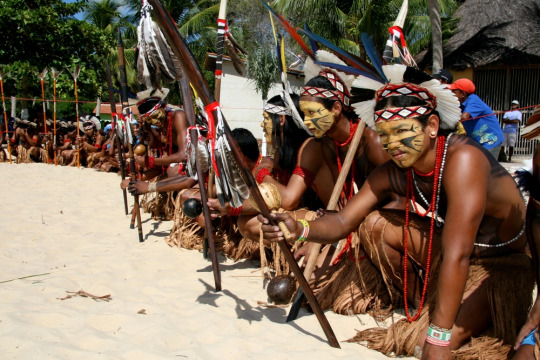
Brazil will soon have its first-ever copy of the 1988 Constitution in an indigenous language, as 15 indigenous translators are currently working on translating the magna carta into Nheengatu, a language spoken by various native groups across the Amazon region.
The initiative is spearheaded by the National Justice Council, a watchdog of the judiciary, and coordinated by the president of the National Library, Marco Luchesi, and José Ribamar Bessa, a professor at the Federal University of Rio de Janeiro.
The translation of the Constitution should be completed by October and will be presented in a ceremony in São Gabriel da Cachoeira, a municipality in the state of Amazonas where Nheengatu is an official language.
Continue reading.
#brazil#politics#indigenous rights#languages#brazilian politics#mod nise da silveira#image description in alt
66 notes
·
View notes
Text
Reading as an articulating axis and practices involving Educational Technologies.
Coucou everyone!
You may have guessed by the title of this post that today our topic is around reading practice, so let's dive together into these letters:

Bursting with creativity was the best thing about being a kid, if you ask me. I remember making the most out of an afternoon in the backyard, by flying to whole new realities in my head. I owe that to all the books I read throughout my childhood. Thanks to my mom, who would always take me to the municipal library, reading was pleasant and satisfying. It was different than watching a movie, for I got some power over the elements presented in the form of words (although we have some world/character description, the final images in our heads might not be the same as what the author originally viewed), creating a deeper connection with the narrative.
As I got older, I tried to read books in English a few times, but it was frustrating. The impatient 15-year-old Laura did not enjoy the fact that she did not know a lot of English words, so the process of looking them up in the dictionary was quite overwhelming, and I could never finish a whole book. After giving up for a while, I tried bilingual books, which have each page in English and in Portuguese. Having the translation of every word makes the reading more fluid and natural, it keeps a story’s sweet flow.
In school, English reading was not the focus. Most of the time, the reading practice was limited to small texts, either on a handout or in the textbook. It was never as interesting as the reading activities in Portuguese, where we had to spot different textual genres and linguistic elements or reflect on the story’s morals. Even though these activities were sometimes not the most appealing, they offered much more possibilities of engagement and comprehension. Today, Brazil’s National Common Curricular Base (BNCC), has taken reading in the English language in a different direction. The reading process should maintain its authenticity, taking into account many important nuances, such as interdisciplinary approach, cultural and linguistic diversity, digital literacy and critical thinking. Further on, the axis of reading in English in basic education is also known as “reading and viewing” and it englobes the skills of reading and comprehending texts in English. Following these guidelines, teachers should be able to work with interesting authentic texts in English, from traditional books to websites, social media posts, news and so on.
In my opinion, the best reading technologies to exist are the simplest and most traditional: google translate and dictionaries. It goes without saying that you’ll find any word you need in dictionaries. But there is so much more than that! In a dictionary you can find a lot of example sentences, synonyms and antonyms. That’s why they will never cease to be a reader’s most important tool, our best friend. Google Translate, on the other hand, might have caused some of you disgust. But it is, in fact, the fastest and most practical translating tool. There are many words that are better understood by translating and a lot of time can be saved this way. Furthermore, on Google Translate there's also the possibility of listening to the pronunciation of the words, which can enrich the reading experience even more.
I really enjoyed writing about the development of reading practices in school! How joyful are these memories! They really inspired me to read for fun more often. I hope that you also get inspired to read something! Don't forget to leave a comment below. See you!
XOXO
Laura
3 notes
·
View notes
Photo

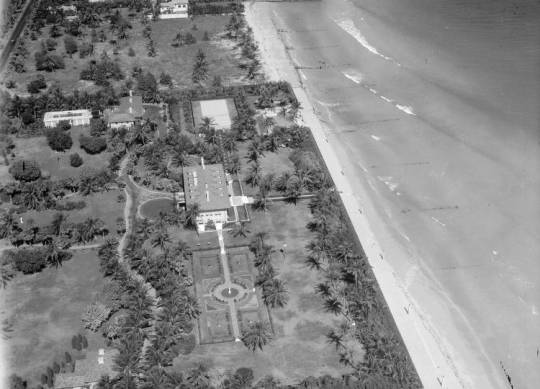

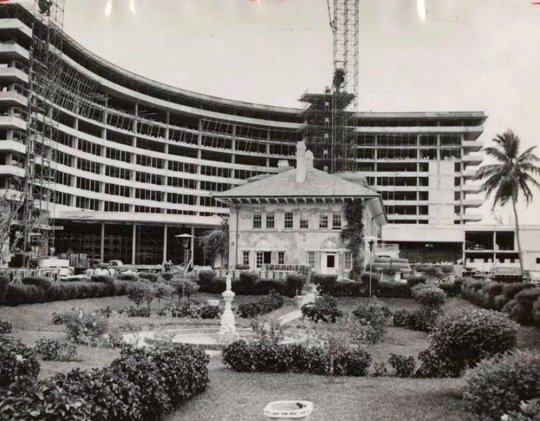
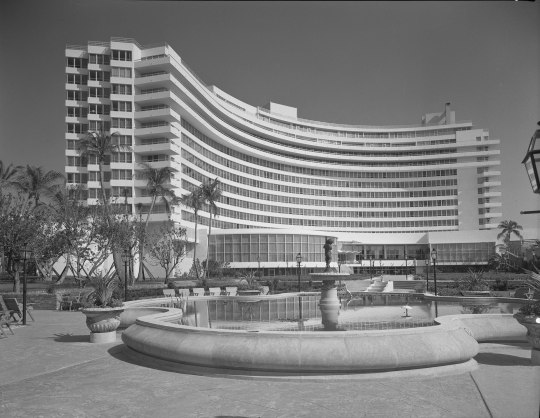
Miami Beach
Snowden Estate, 1923, looking north from 44th St & Collins Ave. Harvey S. Firestone's Harbel Villa Estate, 1930s. Fontainebleau Hotel construction, 1954. Firestone estate was used as a construction office.
Miami History / SMU Libraries / Miami Archives / Gottscho-Schleisner collection, LOC
Fontainebleau architect Morris Lapidus: In his day, critics reviled the excesses of Lapidus’ designs, calling his architecture “the nation’s grossest national product,” “pornography of architecture,” and “boarding house baroque” ... There was a “Staircase to Nowhere” so women dressed in couture and jewels could take an elevator to the top to deposit their coats and glamorously descend the stairs to the lobby. - Fontainebleau Hotel, A Colorful History
Steve Wynn:
In 1954 a guy named Ben Novack and his brother Joe Novack, who had experience in the Catskills at a hotel called Laurel, and in Miami Beach at the Sans Souci Hotel - sort of like Las Vegas with bunch of hotels lined up one next to the other on Collins Avenue - got an option on the Firestone estate at 41st St. on Collins Ave., a big 15-acre oceanfront piece that was owned by the famous family that made tires.
Ben Novack and Joe Novack conceived with an architect named Morris Lapidus of a hotel called Fontainebleau. This place was going to be a new idea. The hotel itself was going to be a series of experiential moments that included formal French gardens, sort of a Jewish version of Versailles; a gorgeous, soaring, high ceiling lobby; a lot of curvilinear spaces and curved stairways; murals on the wall of 18th century France; a fabulous showroom; a shopping arcade below; beyond the garden an expansive Cabana and pool club; a beautiful spa; and a curved building with blue glass. The Fontainebleau was going to set a new standard of destination resorts on planet Earth. It was so breakaway, so profoundly new it didn't even add a name on it. No sign, just the building.
It opened in 1954 and it changed everything people came from France, Italy, Germany, Mexico, Venezuela, Argentina, and Brazil. Between Christmas and Easter you had to know somebody to get a room. Everybody from Frank Sinatra and Johnny Mathis worked there. It was the coolest place to be in America during high season. The Fontainebleau dwarfed in scale and imagination anything that had ever been done anywhere in Europe or America, and it was received that way.
Jay Sarno was a character from Atlanta. He saw the Fontainebleau. He saw that this place was in the literary sense romantic, better than the outside world. It was a universe utopia within itself. Sarno never got over it
I was going to school at the University of Pennsylvania. My folks had Cabana 364 on an annual basis. I’d come there at Christmastime, and I never got over it. To me it seemed like the greatest thing in the world is to create a place that would transport people that way.
11 notes
·
View notes
